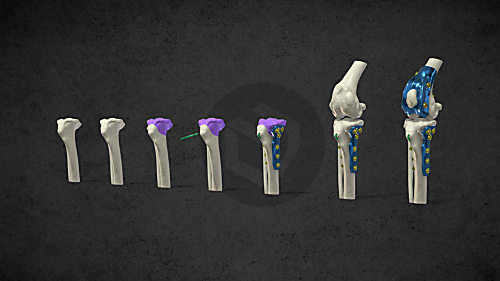The Advantages of LimesVet Services for Your Veterinary Practice
Precise planning, safer surgeries! Integrate 3D technology into your veterinary practice and take advantage of the innovative solutions we offer.
Virág, the 2-year-old Yorkshire terrier hosted by Állat és Ember Állatvédő Egyesület \[“Animal and Human” Animal Protection Association], was first admitted to FuzioVet Animal Hospital because of the serious lameness of her left hind leg. So, Dr Antal Seregi carried out lameness examination on her. Her condition was diagnosed as serious limb malformation due to the congenital deformity of the left femur and the left tibia resulting in a fourth-degree medial patellar luxation - the inward dislocation of the patella. This was the cause of her lameness. The serious limb deformity necessitated the mapping of the ill bones, by performing CT scan after the classical X-ray examination. By doing so, it was possible to obtain a detailed image of the deformation. After the CT scan a team of professionals analysed the images with our vet colleague, Dr Kálmán Czeibert, and drew the conclusion that the bones in the limb shall be 3D printed so that the team can specify the precise details of the planned operation. In Hungary this was the first complex orthopaedic operation whose planning involved printed bones as well. The first operation aimed at correcting the deformity of the femur and the tibia so that the structure of the bones improves. However, Virág’s limb usage was not significantly better at this stage after the operation. It could be explained by her two years of age - the atrophy of her muscles evolving in the course of this period of time - and the malformation of the ligaments in her knee. As a result, we had to come up with an operation solution which provides Virág with the ability to fully use her knee and to live a painless life. This was the moment when we decided to design a total knee prosthesis customised to Virág’s needs ensuring that this prosthesis fits her faulty bones as much as possible. We considered several factors in the course of the 6 months of planning. We also dived into the 3D printing of medical implants in titanium and we planned all the steps of the operation, which took place in February 2023. The operation was smooth and everything went according to plan. Then, on the 4th day after the operation the most difficult period of the healing process started: rehabilitation. The physiotherapists at Ebfizio treated Virág twice a week and massaged her leg four times every day which resulted in her excellent limb usage three months after the operation. Nevertheless, Virág is not fully healed yet because stopping the atrophy of her muscles, enhancing the mass of her muscles and the easement of the contracture occurring in the course of 2.5 years still require plenty of time and energy. However, Virág does not simply endure these treatments, she loves them.

Precise planning, safer surgeries! Integrate 3D technology into your veterinary practice and take advantage of the innovative solutions we offer.

The combined application of custom 3D-printed and traditional implants represents a significant advancement in treating complex orthopedic conditions.

During the COVID-19 lockdowns, many people sought emotional support amid isolation and uncertainty. However, home office opened new opportunities for a young woman: finally, she could adopt a puppy. In the interview she talks about how thanks to this her life changed, how she found new social relationships and how her dog helped her maintain her mental health during this difficult period.
Personalized implants
Personalized implants
Personalized implants